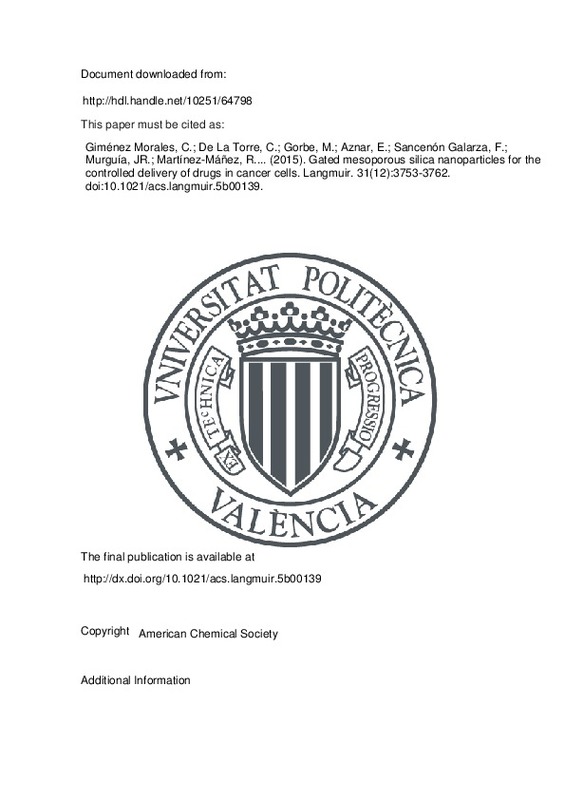Giménez Morales, C.; De La Torre, C.; Gorbe, M.; Aznar, E.; Sancenón Galarza, F.; Murguía, JR.; Martínez-Máñez, R.... (2015). Gated mesoporous silica nanoparticles for the controlled delivery of drugs in cancer cells. Langmuir. 31(12):3753-3762. https://doi.org/10.1021/acs.langmuir.5b00139
Por favor, use este identificador para citar o enlazar este ítem: http://hdl.handle.net/10251/64798
|
Título:
|
Gated mesoporous silica nanoparticles for the controlled delivery of drugs in cancer cells
|
|
Autor:
|
Giménez Morales, Cristina
de la Torre, Cristina
Gorbe, Mónica

 Aznar, Elena
Aznar, Elena

 Sancenón Galarza, Félix
Sancenón Galarza, Félix

 Murguía, Jose R.
Murguía, Jose R.

 Martínez-Máñez, Ramón
Martínez-Máñez, Ramón

 Marcos Martínez, María Dolores
Amoros del Toro, Pedro Jose
Marcos Martínez, María Dolores
Amoros del Toro, Pedro Jose
|
|
Entidad UPV:
|
Universitat Politècnica de València. Departamento de Química - Departament de Química
Universitat Politècnica de València. Instituto de Reconocimiento Molecular y Desarrollo Tecnológico - Institut de Reconeixement Molecular i Desenvolupament Tecnològic
Universitat Politècnica de València. Departamento de Biotecnología - Departament de Biotecnologia
|
|
Fecha difusión:
|
|
|
Resumen:
|
In recent years, mesoporous silica nanoparticles (MSNs) have been used as effective supports for the development of controlled-release nanodevices that are able to act as multifunctional delivery platforms for the encapsulation ...[+]
In recent years, mesoporous silica nanoparticles (MSNs) have been used as effective supports for the development of controlled-release nanodevices that are able to act as multifunctional delivery platforms for the encapsulation of therapeutic agents, enhancing their bioavailability and overcoming common issues such as poor water solubility and poor stability of some drugs. In particular, redox-responsive delivery systems have attracted the attention of scientists because of the intracellular reductive environment related to a high concentration of glutathione (GSH). In this context, we describe herein the development of a GSH-responsive delivery system based on poly(ethylene glycol)- (PEG-) capped MSNs that are able to deliver safranin O and doxorubicin in a controlled manner. The results showed that the PEG-capped systems designed in this work can be maintained closed at low GSH concentrations, yet the cargo can be delivered when the concentration of GSH is increased. Moreover, the efficacy of the PEG-capped system in delivering the cytotoxic agent doxorubicin in cells was also demonstrated.
[-]
|
|
Palabras clave:
|
POLYMER HYBRID NANOPARTICLES
,
CONTROLLED-RELEASE
,
ENHANCED PERMEABILITY
,
INORGANIC NANOPARTICLES
,
TRIGGERED RELEASE
,
GUEST MOLECULES
,
IN-VITRO
,
GLUTATHIONE
,
SYSTEMS
,
SUPPORTS
|
|
Derechos de uso:
|
Reserva de todos los derechos
|
|
Fuente:
|
Langmuir. (issn:
0743-7463
)
|
|
DOI:
|
10.1021/acs.langmuir.5b00139
|
|
Editorial:
|
American Chemical Society
|
|
Versión del editor:
|
http://dx.doi.org/10.1021/acs.langmuir.5b00139
|
|
Código del Proyecto:
|
info:eu-repo/grantAgreement/MINECO//MAT2012-38429-C04-01/ES/DESARROLLO DE MATERIALES FUNCIONALIZADOS CON PUERTAS NANOSCOPICAS PARA APLICACIONES DE LIBERACION CONTROLADA Y SENSORES PARA LA DETECCION DE NITRATO AMONICO, SULFIDRICO Y CO/
info:eu-repo/grantAgreement/GVA//PROMETEOII%2F2014%2F047/ES/Nuevas aproximaciones para el diseño de materiales de liberación controlada y la detección de compuestos peligrosos/
info:eu-repo/grantAgreement/UPV//SP20120795/
|
|
Agradecimientos:
|
The authors thank the Spanish Government (Project MAT2012-38429-C04-01), the Generalitat Valenciana (Project PROMETEOII/2014/047), and the Universitat Politecnica de Valencia (Project SP20120795) for support. C.G. and ...[+]
The authors thank the Spanish Government (Project MAT2012-38429-C04-01), the Generalitat Valenciana (Project PROMETEOII/2014/047), and the Universitat Politecnica de Valencia (Project SP20120795) for support. C.G. and C.d.l.T also thank the Spanish Ministry of Education for their FPU grants. The authors also thank UPV electron microscopy and CIPF confocal microscopy services for technical support.
[-]
|
|
Tipo:
|
Artículo
|







![[Cerrado]](/themes/UPV/images/candado.png)


